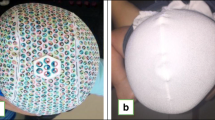Abstract
Purpose
The aim of this study was to investigate the optimal age for starting cranial-remolding-orthosis therapy in children with deformational plagiocephaly.
Methods
Medical records of 310 patients with deformational plagiocephaly were retrospectively reviewed and the initial and final cranial vault asymmetry index (CVAI), age when starting therapy, duration of therapy, mean change of CVAI, improvement rate, and treatment success were analyzed. We compared outcomes according to the groups divided by ages starting therapy.
Results
There were no significant differences in improvement rate and duration of cranial-remolding-orthosis therapy among patients starting therapy at the age of 3, 4, and 5 months. However, when starting therapy after the age of 6 months, the rates of CVAI improvement were significantly lower and the duration of therapy was significantly increased.
Conclusion
Considering the spontaneous resolution effect according to the head growth nature, the age 5 month is the optimal period to start cranial-remolding-orthosis therapy for deformational plagiocephaly.




Similar content being viewed by others
References
Kelly KM, Littlefield TR, Pomatto JK, Manwaring KH, Beals SP (1999) Cranial growth unrestricted during treatment of deformational plagiocephaly. Pediatr Neurosurg 30:193–199. doi: 28794
Bialocerkowski AE, Vladusic SL, Wei Ng C (2008) Prevalence, risk factors, and natural history of positional plagiocephaly: a systematic review. Dev Med Child Neurol 50:577–586. doi:10.1111/j.1469-8749.2008.03029.x
Looman WS, Flannery AB (2012) Evidence-based care of the child with deformational plagiocephaly, part I: assessment and diagnosis. J Pediatr Health Care 26:242–250; quiz 251-243. doi:10.1016/j.pedhc.2011.10.003
Mortenson P, Steinbok P, Smith D (2012) Deformational plagiocephaly and orthotic treatment: indications and limitations. Childs Nerv Syst 28:1407–1412. doi:10.1007/s00381-012-1755-3
Aihara Y, Komatsu K, Dairoku H, Kubo O, Hori T, Okada Y (2014) Cranial molding helmet therapy and establishment of practical criteria for management in Asian infant positional head deformity. Childs Nerv Syst 30:1499–1509. doi:10.1007/s00381-014-2471-y
Speltz ML, Collett BR, Stott-Miller M, Starr JR, Heike C, Wolfram-Aduan AM, King D, Cunningham ML (2010) Case-control study of neurodevelopment in deformational plagiocephaly. Pediatrics 125:e537–542. doi:10.1542/peds.2009-0052
Collett BR, Gray KE, Starr JR, Heike CL, Cunningham ML, Speltz ML (2013) Development at age 36 months in children with deformational plagiocephaly. Pediatrics 131:e109–e115. doi:10.1542/peds.2012-1779
Cabrera-Martos I, Valenza MC, Valenza-Demet G, Benitez-Feliponi A, Robles-Vizcaino C, Ruiz-Extremera A (2016) Effects of manual therapy on treatment duration and motor development in infants with severe nonsynostotic plagiocephaly: a randomised controlled pilot study. Childs Nerv Syst 32:2211–2217. doi:10.1007/s00381-016-3200-5
Dorhage KW, Beck-Broichsitter BE, von Grabe V, Sonntag A, Becker ST, Wiltfang J (2016) Therapy effects of head orthoses in positional plagiocephaly. J Craniomaxillofac Surg 44:1508–1514. doi:10.1016/j.jcms.2016.06.035
Graham JM Jr, Gomez M, Halberg A, Earl DL, Kreutzman JT, Cui J, Guo X (2005) Management of deformational plagiocephaly: repositioning versus orthotic therapy. J Pediatr 146:258–262. doi:10.1016/j.jpeds.2004.10.016
Kluba S, Kraut W, Reinert S, Krimmel M (2011) What is the optimal time to start helmet therapy in positional plagiocephaly? Plast Reconstr Surg 128:492–498. doi:10.1097/PRS.0b013e31821b62d6
Thompson JT, David LR, Wood B, Argenta A, Simpson J, Argenta LC (2009) Outcome analysis of helmet therapy for positional plagiocephaly using a three-dimensional surface scanning laser. J Craniofac Surg 20:362–365. doi:10.1097/SCS.0b013e3181992382
Mulliken JB, Vander Woude DL, Hansen M, LaBrie RA, Scott RM (1999) Analysis of posterior plagiocephaly: deformational versus synostotic. Plast Reconstr Surg 103:371–380
Plank LH, Giavedoni B, Lombardo JR, Geil MD, Reisner A (2006) Comparison of infant head shape changes in deformational plagiocephaly following treatment with a cranial remolding orthosis using a noninvasive laser shape digitizer. J Craniofac Surg 17:1084–1091. doi:10.1097/01.scs.0000244920.07383.85
Freudlsperger C, Steinmacher S, Saure D, Bodem JP, Kuhle R, Hoffmann J, Engel M (2016) Impact of severity and therapy onset on helmet therapy in positional plagiocephaly. J Craniomaxillofac Surg 44:110–115. doi:10.1016/j.jcms.2015.11.016
Yoo HS, Rah DK, Kim YO (2012) Outcome analysis of cranial molding therapy in nonsynostotic plagiocephaly. Arch Plast Surg 39:338–344. doi:10.5999/aps.2012.39.4.338
Clarren SK, Smith DW, Hanson JW (1979) Helmet treatment for plagiocephaly and congenital muscular torticollis. J Pediatr 94:43–46
Loveday BP, de Chalain TB (2001) Active counterpositioning or orthotic device to treat positional plagiocephaly? J Craniofac Surg 12:308–313
Clarren SK (1981) Plagiocephaly and torticollis: etiology, natural history, and helmet treatment. J Pediatr 98:92–95
Littlefield TR (2001) Food and Drug Administration regulation of orthotic cranioplasty. Cleft Palate Craniofac J 38:337–340. doi:10.1597/1545-1569(2001)038<0337:fadaro>2.0.co;2
van Wijk RM, van Vlimmeren LA, Groothuis-Oudshoorn CG, Van der Ploeg CP, Ijzerman MJ, Boere-Boonekamp MM (2014) Helmet therapy in infants with positional skull deformation: randomised controlled trial. Bmj 348:g2741. doi:10.1136/bmj.g2741
Bruner TW, David LR, Gage HD, Argenta LC (2004) Objective outcome analysis of soft shell helmet therapy in the treatment of deformational plagiocephaly. J Craniofac Surg 15:643–650
Kim SY, Park MS, Yang JI, Yim SY (2013) Comparison of helmet therapy and counter positioning for deformational plagiocephaly. Ann Rehabil Med 37:785–795. doi:10.5535/arm.2013.37.6.785
Xia JJ, Kennedy KA, Teichgraeber JF, Wu KQ, Baumgartner JB, Gateno J (2008) Nonsurgical treatment of deformational plagiocephaly: a systematic review. Arch Pediatr Adolesc Med 162:719–727. doi:10.1001/archpedi.162.8.719
Kluba S, Kraut W, Calgeer B, Reinert S, Krimmel M (2014) Treatment of positional plagiocephaly--helmet or no helmet? J Craniomaxillofac Surg 42:683–688. doi:10.1016/j.jcms.2013.09.015
Miller RI, Clarren SK (2000) Long-term developmental outcomes in patients with deformational plagiocephaly. Pediatrics 105:E26
Robinson S, Proctor M (2009) Diagnosis and management of deformational plagiocephaly. J Neurosurg Pediatr 3:284–295. doi:10.3171/2009.1.peds08330
Lee RP, Teichgraeber JF, Baumgartner JE, Waller AL, English JD, Lasky RE, Miller CC, Gateno J, Xia JJ (2008) Long-term treatment effectiveness of molding helmet therapy in the correction of posterior deformational plagiocephaly: a five-year follow-up. Cleft Palate Craniofac J 45:240–245. doi:10.1597/06-210.1
Acknowledgments
We appreciate Orthokorea® that provided data for this research.
Author information
Authors and Affiliations
Corresponding author
Ethics declarations
Conflict of interest
Mi-hyang Han: No conflict of interest to disclose. Jin Young Kang: No conflict of interest to disclose. Hye Young Han: No conflict of interest to disclose. Yun-hwa Cho: No conflict of interest to disclose. Dae-Hyun Jang: No conflict of interest to disclose.
Rights and permissions
About this article
Cite this article
Han, Mh., Kang, J.Y., Han, H.Y. et al. Relationship between starting age of cranial-remolding-orthosis therapy and effectiveness of treatment in children with deformational plagiocephaly. Childs Nerv Syst 33, 1349–1356 (2017). https://doi.org/10.1007/s00381-017-3427-9
Received:
Accepted:
Published:
Issue Date:
DOI: https://doi.org/10.1007/s00381-017-3427-9




